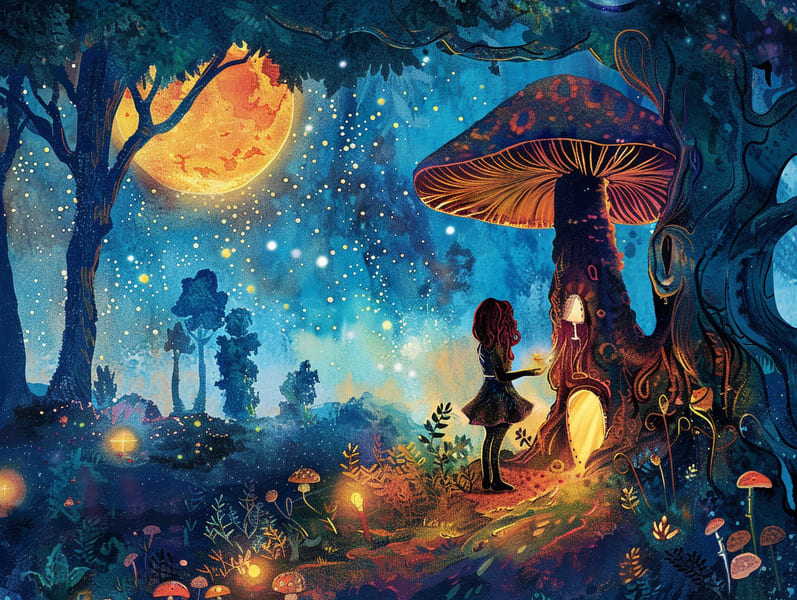The Story Behind Children's Fairy Tales and the Unending Beauty.
The Story Behind Children's Fairy Tales and the Unending Beauty.
Blog Article

Famous fairy tales have old origins. These narratives have been passed down from one generation to the next far before they were ever inscribed. They came from a variety of cultures, including Western traditions. They were initially transmitted among older generations, often carrying themes and messages reflective of the societal norms and beliefs of the time.
Jacob and Wilhelm Grimm, Jacob and Wilhelm, were among the first to compile and publish many of these beloved fairy tales. Their collection, "Grimm's Story Collection," included stories like "Ashenputtel," "The Story of Hansel and Gretel," and "Snow-White and Rose-Red," which have since become staples in the world of children's fairy tales. Similarly, Hans Andersen's magical stories, such as "The Sea Maid," and "The Story of the Ugly Duckling," have captivated hearts worldwide, ensuring their place in the pantheon of famous fairy tales.
Even though they are old, fairy tales remain as relevant as ever, especially as children's bedtime stories. These fantastical tales are now available in various formats, including colorful picture books, delightful animations, and free fairy tales online.
Their lasting presence can be linked to several delightful features:
Important Morals: Old fairy tales often convey important moral lessons. Fairy tales like "The Story of the Boy Who Cried Wolf" teach the virtue of truthfulness, while "The Hare and the Tortoise" show the traits of persistence and humbleness. These tales offer the young clear distinctions between good and bad, forming their moral compass in a tender yet deep way.
Warmth and Understanding: Classic fairy tales frequently depict personalities facing challenges and struggles, stimulating young readers to comprehend with their struggles and support their triumphs. For instance, "Beauty and the Beast" illustrates the necessity of looking deeper to see the real person of a individual, advancing kindness and recognition.
Cultural Appreciation: Many ancient fairy tales are interwoven with the cultural contexts from which they came. Discovering these narratives can provide intriguing perspectives into different beliefs, fostering a sense of global understanding and perception.
Imagination and Innovation: The fantastical elements in timeless fairy tales—enchanted lands—generate children’s visions. These stories take readers to fantastical realms, enhancing innovative thinking and a sense of marvel that persists a lifetime.
Old fairy tales are not only fantastical but also teaching. They provide captivating tools in building various cognitive and emotional skills in young readers. When classic fairy tales are spoken, they promote language proficiency by presenting new language and detailed sentence structures. This practice also advances listening skills and mindfulness, as young ones track the narrative, looking forward to see what happens next.
Furthermore, discussing the themes and characters of fairy tales can enhance evaluative skills and logical thinking. Children are instructed to notice patterns, anticipate outcomes, and understand cause and effect. These talks also contribute to young readers articulate their thoughts and feelings, strengthening their emotional intelligence.
In today’s technological era, the prevalence of web-based fairy tales has made these fairy tales more acquirable than ever. Websites and web apps extend wide arrays of bedtime fairy tales that can be looked at or listened on anytime, anywhere. Fairy tales read out loud are particularly prevalent, presenting an immersive method for young readers to enjoy these fascinating tales. Audiobooks and spoken videos move characters and settings to life, often joined by captivating sound effects and music that amplify the story adventure.
The timeless fascination of traditional fairy tales lies in their ability to alter to the present while keeping hold of their key morals. Contemporary versions of these tales often integrate more varied characters and modern settings, making them relevant to today’s audience. However, the core values of courage, charity, and justness remain unchanged, continuing to appeal to kids of all ages.
Old fairy tales also offer a sense of assurance and familiarity. They make accessible a well-structured narrative with a clear beginning, middle, and end, often winding up with the closure of conflicts and the triumph of good over bad. This predictability can be encouraging for little ones, providing a sense of sturdiness website in an fluctuating world.
Traditional fairy tales continue to charm and train new generations, maintaining their mystique and relevance in modern society. As nighttime stories for kids, they yield a perfect blend of fantasy and learning, aiding moral values, empathy, and creativity. The availability of digital fairy tales and the likability of fairy tales narrated promise that these ancient fairy tales remain reachable to new generations.
By guarding and releasing these tales, we continue to exalt the rich tapestry of cultural heritage and cultural heritage. Whether you are browsing a beautifully illustrated book, enjoying a electronic library, or listening on an read-aloud story, the fascination of ancient fairy tales is always within reach. These tales convey of the persistent nature of tales and its ability to bond us across epochs and places.
Be it you are experiencing a vividly illustrated book, discovering a internet library, or listening via an voice book, the magic of Grimm's fairy tales is always within reach.
These narratives show us of the unwavering effect of fairy tales and its ability to join us across time and space, weaving a spell that delights and instructs alike.